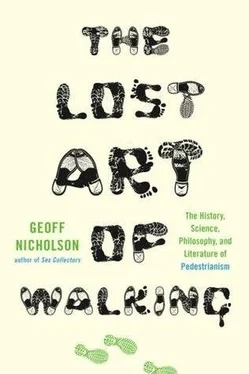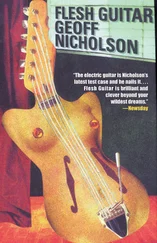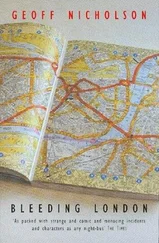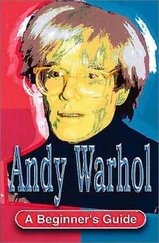♦
I had always thought that Muybridge’s work was the inspiration for Marcel Duchamp’s Nude Descending a Staircase , but Duchamp himself rather vaguely claimed to have been inspired by the later work of Etienne-Jules Marey, a scientist first and a photographer second (the opposite of Muybridge). Marey was a physiologist, the inventor of chronophotography, who investigated the movements of birds and insects and a whole menagerie of animals before turning his attention to human locomotion. He was a contemporary of Muybridge’s and they were aware of each other, but most of his work on human locomotion came after Muybridge’s. Marey did, however, pioneer the use of ‘motion capture’ suits, with white stripes on the arms and legs to record motion, the kind of thing used today in computer animation and regarded as very high-tech.
♦
Incidentally, the process Muybridge used to investigate equine trotting would pretty much destroy the human sport of racewalking. Historically, walking was defined as a form of locomotion in which a part of the foot always had to be in contact with the ground, giving rise to the bizarre and faintly ludicrous gait of the serious racewalker. But modern cameras are so rigorous in their gaze, they show that the vast majority of racewalkers, even the very best of them, fail this basic test. The naked eye can’t pick up the airborne moment but a modern camera certainly can. Attempts have been made to redefine the sport in terms of what the naked eye can or can’t detect, but that’s clearly unsatisfactory. You either leave the ground or you don’t. Once technology has determined that most of a sport’s practitioners are breaking the sport’s most basic rule, things are unlikely to go well.
♦
And so I went to visit Bruce Gilden, the man Martin Parr considered the greatest pure street photographer and, as I discovered, one of New York’s fiercest walkers. He specializes in gritty, grainy, black-and-white, flash-lit grotesques, the misshapen, the troubled, and the troubling. He’s drawn to the ones with the bad skin and the bad teeth, with noses that jut and droop, mouths that hang slackly open or clench with tension or around fat cigars. He’s a fan of bad makeup, bad hair, bad wigs, of clothes that are too big or too small, out of style or were never quite in style in the first place. Sometimes his characters look terrifying — sometimes they look terrified. They may be wild-eyed or dead-eyed, obese or skeletal, mad or maddening, scarred or deformed, hyperaware or utterly oblivious. If he can get a couple of these opposing types in the same frame, that’s great, but often the frame is so tight it will only hold one person. Gilden operates at close range, Leica in one hand, flashgun in the other. There’s nothing discreet or clandestine about the process. He’s right in the faces of his subjects. They are in transit, in turmoil, and it’s only the flash and the magic of the camera that freeze and hold them still for a moment before the chaos engulfs them again. Bruce Gilden and New York were made for each other.
I met him in the offices of the Magnum photo agency in Manhattan. He was sixtyish, lean, balding, bearded, scruffy in a comfortable way, alert, intense, big-eyed, a serious man who laughs a lot. A part of Gilden conforms to everybody’s idea of what a New Yorker is or should be: motormouthed, tough, abrupt yet warm.
I tried to explain why I wanted to talk to him and gave him my spiel about street photographers having to do a lot of walking and in the process photographing a lot of walkers.
‘Sure’, he said. ‘If you don’t walk you’re not gonna get the picture’.
That might have been the end of it right there. Fortunately, Bruce Gilden is a man who likes to talk.
‘My style’, he said, ‘is very predatory, like Moriyama had a book called The Hunter years ago and I was always intrigued by the title. When I started, I liked these social-documentary-type photographs. Dorothea Lange, Henri Cartier-Bresson. I like the street. I like being around people. Well, I do and I don’t, OK.
‘Anyway, when I started I went to Coney Island and did work on Coney Island, because for me I don’t like to talk to people, I mean I will if I have to in the street, but I’m basically shy and also I have a fear factor. I’m a physical guy, I’m quick-tempered, so what that means is that I’m afraid of violence but also I’m violent. I have a very good sense of where danger is, who can be dangerous, I’m streetwise, OK, so having said that, you know when you put your camera up and put it in someone’s face and you come from a background like mine there could be fire, you know, it could be quite bad, so I’ve learned to have a very good bedside manner.
‘In the early days I went to Coney Island because it’s a meeting area, there were people there, interesting kinds of people. You didn’t have to ask to photograph people. You could ask if you wanted to but you’re in a freak zone, so why ask?
‘The pictures I took were quite traditional, documentary pictures. Cartier-Bresson was an influence — well, I shouldn’t say that. I liked his pictures OK, and I was able to do that type of picture, but then I said, ‘Wait a second, who could do Cartier-Bresson better than Cartier-Bresson? Why would I want to be a little Bresson? What could I add to it?’ So it evolved. I liked film noir. My influence is black-and-white television, and my father. My father was a film-noir character — he was about five foot seven, two hundred twenty pounds, gray hair, pinkie ring, smoked cigars, racketeer-looking. I idolized him when I was five years old. He was everything. He was the fireman, he was George Washington, you name it, it was him’.
Had he ever photographed his father?
‘No, because I don’t photograph people I know, maybe because I am very ironic and very satirical and sarcastic, so I don’t. People have said in the past, and in the present also, but it has been said that what Bruce does is really easy, he photographs characters. No. It’s not easy’.
And why so confrontational, so in your face?
‘I don’t want to be accused of sneaking something. ‘Hey you, are you taking a picture of me? What are you? A sneak?’ But sometimes I’m so close that people think, ‘Oh yeah, he took a picture of something back there behind me because he can’t be that close’. But when you use the flash people know you took a picture. You can’t say, ‘I didn’t take a picture’. So I’m quite honest usually unless there’s really a lot of danger.
‘Since I’m quite an emotional type of guy, a physical type of guy, was a good athlete, and I like to be close to people ‘cause I want to take their guts out, it evolved that I would get very close and use a flash.
‘I used to have a schedule. No longer. I used to try to go out every day. Now I haven’t been out for two months. I had jobs, my daughter was playing soccer in England, but generally I would go out about two, two-thirty in the afternoon and stay out till it gets almost dark, but the problem here for me is that I’ve been on the street so long, you know, I’m trotting over the same ground. And there aren’t so many characters as there used to be, so you know the city is shifting, I’m getting older, things are changing, the world is smaller’.
I’d heard that he had certain set daily routes that he’d walk constantly while looking for people to photograph.
‘Sure. I’d go on Fifth Avenue from like Forty-ninth Street to Fifty-seventh, up and down, up and down, up and down, one side of the street, too, not the other, the west side. It’s quite funny, you know. And Broadway between Forty-third and Forty-seventh, the west side, it’ll be darker on that side of the street.
‘I used to work Forty-second Street when it was a little bit of a hovel, but you had to be careful there, people really didn’t want to be photographed. When I photographed there in the mid-eighties you had these young kids pickpocketing people, black kids, and one day, you know, I had my camera and they gave me a little shit, they were maybe thirteen but they weren’t little, and I said to the guy, ‘Listen, if you don’t like it let’s go round the corner’. That’s the way I felt, OK, so we became friendly, OK, then about five, six years later I’m on the train, I must have been living in Brooklyn Heights, and I saw the kid. I didn’t know him but I said, ‘Hi, how you been?’ and he said, ‘Oh, I’ve been in prison, you know’. These were no good, these kids, so their whole life would be in and out of prison, so we talked a little bit and…’
Читать дальше












